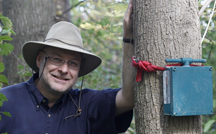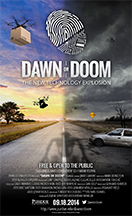Natural soundscapes may become ‘digital fossils’ of the future
September 11, 2014
 |
|
Bryan Pijanowski |
WEST LAFAYETTE, Ind. - Sounds are integral to Henry David Thoreau’s “Walden,” the book about two years he spent living in a cabin in the woods near Walden Pond in Massachusetts in 1846-47 - the wind blowing through the rushes, the rumbling of the ice melting in the spring, owls screeching in the night.
Oh, and the whistle of the steam engines from passing trains and church bells ringing in Concord on Sundays, miles away. Thoreau went to Walden to live simply amid nature. The sounds of humanity followed him. Now, there is hardly a spot on the planet where our noise doesn’t mix with (or intrude on, from another perspective) the sounds of the natural world, says Purdue University Professor Bryan Pijanowski.
Eventually, the only way people may be able to hear nature on its own terms is through an artificial digital world, much like “Star Trek,” says Pijanowski, an ecologist leading a Purdue-centered international effort to collect a digital archive of high-resolution video - and especially sound - from signature natural areas around the world.
“That could be all we have left,” says the Purdue forestry and natural resources professor. “We put on our Google glasses, we put on headphones, we put on whatever immersive technology develops, and that's the only way for us to go to nature."
Had he the means, Thoreau could have traveled from Massachusetts and found himself in pristine natural soundscapes all over the planet. Today, it is difficult to stand and hear nothing but nature for very long even in many of the remotest places, from rain forests in South America to the arctic tundra.
“The noise that blankets the land, the noise that blankets the sea, is virtually ubiquitous,” Pijanowski says. “We have shipping channels that go through the Arctic. We have planes that fly everywhere in the world. Passenger airplane traffic continues to skyrocket. So the question I have for people is: Where can we protect our natural spaces and enjoy it as an experience that's simply a person in nature?”
It is a question Pijanowski will raise during a lecture titled “Digital Nature” at a Purdue conference called “Dawn or Doom: The New Technology Explosion.”
The Dawn or Doom conference is being held Thursday (Sept. 18) on the Purdue West Lafayette campus and is free and open to the public.
“Soundscape ecology” projects that Pijanowski and his students engage in with collaborators worldwide are intended, in part, to encourage people to think about the issue. Among other things, they mounted a Record the Earth Initiative on Earth Day - April 22 - to encourage people to capture and upload natural sound recordings for preservation with a specially developed Soundscape Recorder app on smartphones.
 |
If technology has helped blanket much of the Earth in manmade noise, as well as enabled us to tune out the din with headphones that provide our own personal soundscapes, technology also has the potential to help ameliorate the situation, Pijanowksi says.
“If we could focus on how the technology's making the noise, we could focus on solving it with technology,” he says. “Can't we make quieter planes, quieter vehicles, quieter pavement, plan our cities in ways that allow people to escape to places that have both the high-quality visual experience but also the quiet?”
The latest technologies also allow scientists to record visual and acoustic data at such enormous rates they have trouble analyzing all of it and at a fidelity that makes the experience of seeing and hearing it like being there. Pijanowski’s soundscape archive is so large that it would take more than one lifetime to listen to it all and much of it is online.
Pijanowski and other researchers mine this data trove to learn dynamics of nature that have not been observed before. Pijanowksi’s lab combines ecology, engineering, social science and the arts in its research, applying for example music theory to help quantify and characterize natural soundscapes.
“In my work, I attempt to capture all of these data streams so that others may be inspired by the incredible beauty, visually and acoustically, of exotic places,” Pijanowski says.
“In many ways these are going to become digital fossils for future generations. But my fear is that that's all we'll have of nature in the future.”
Writer: Greg Kline, 765-494-8167, gkline@purdue.edu
Source: Bryan Pijanowski, 765-496-2215, bpijanow@purdue.edu

